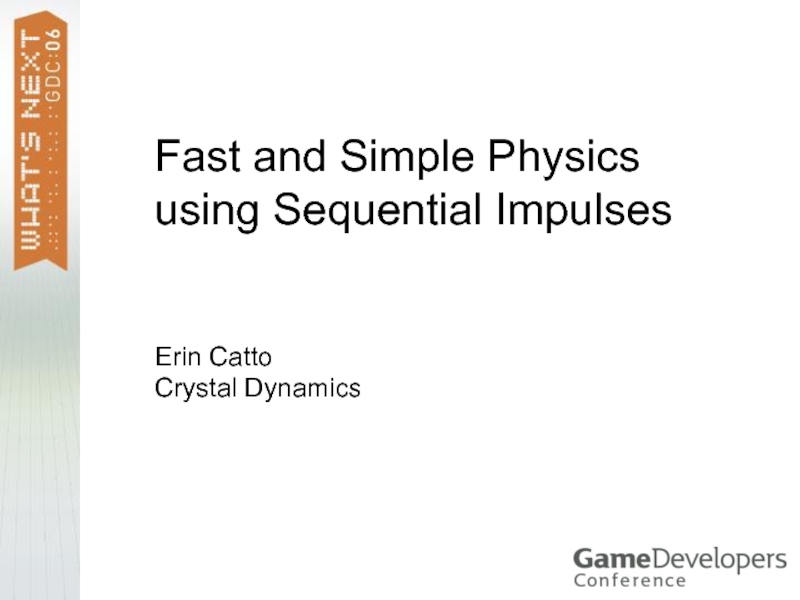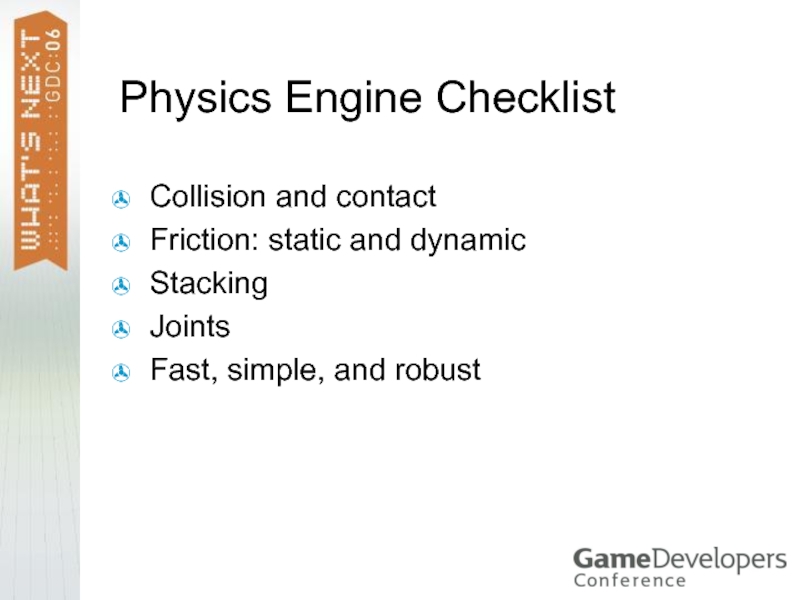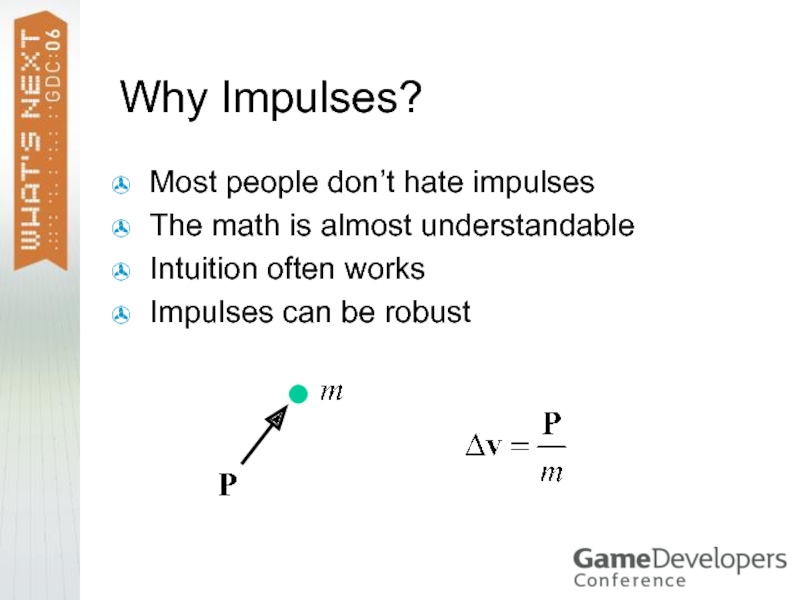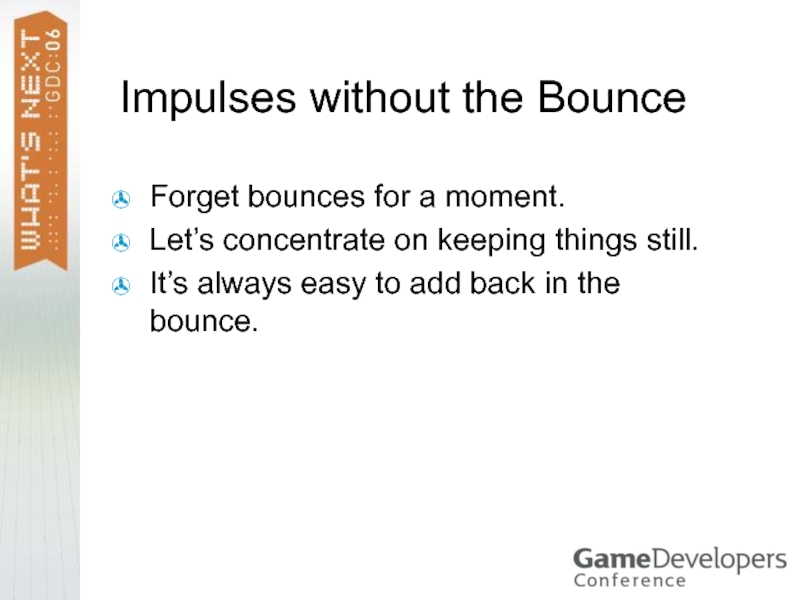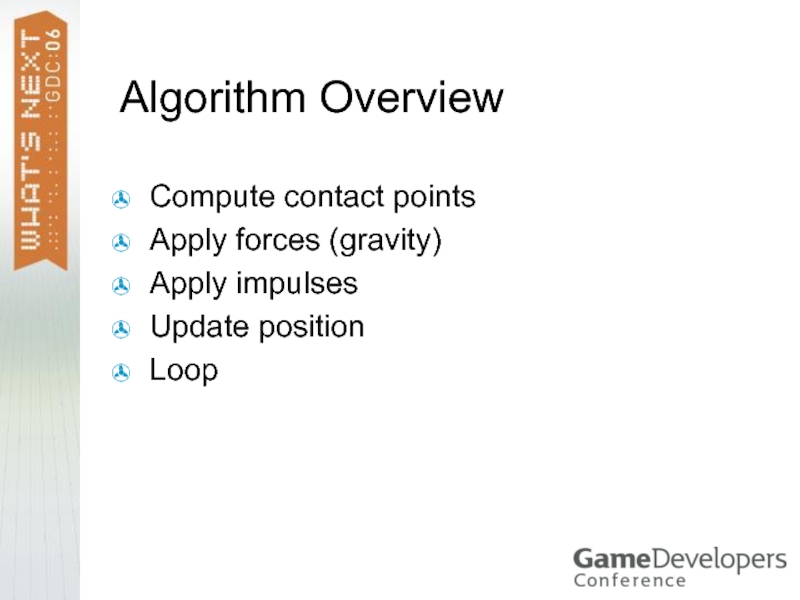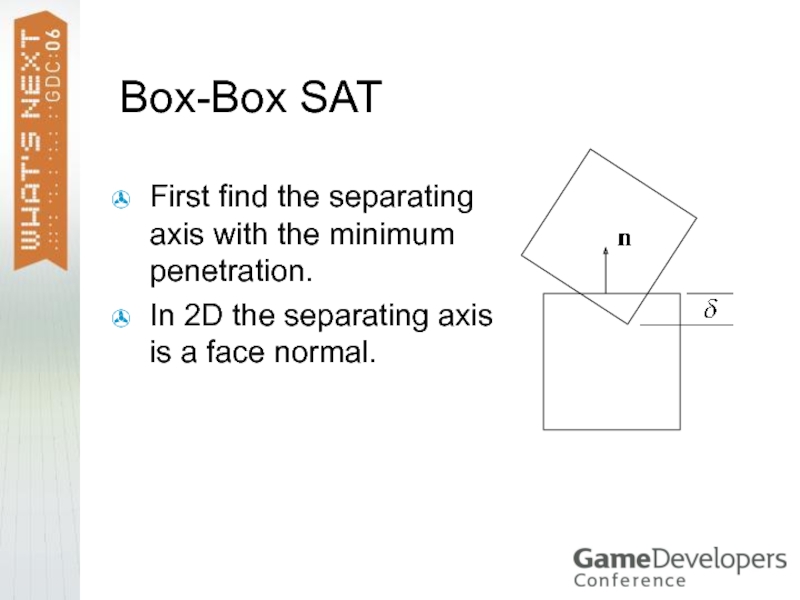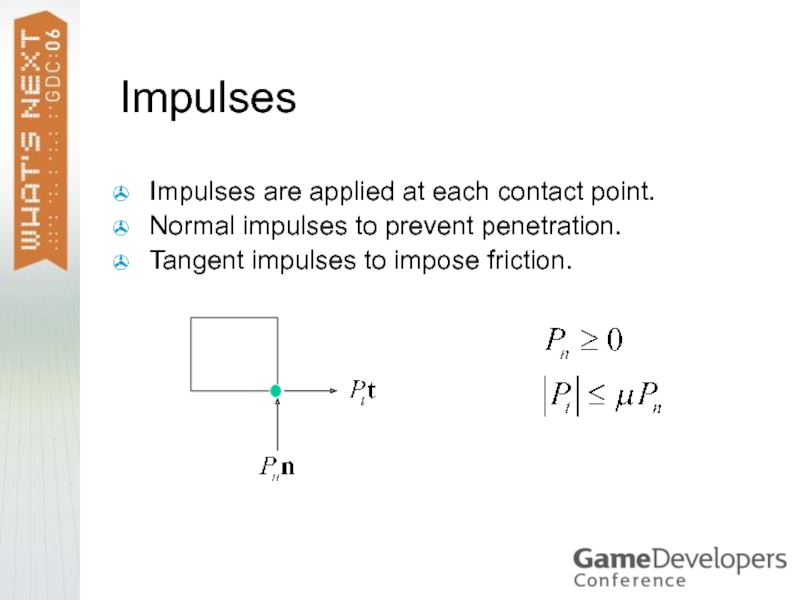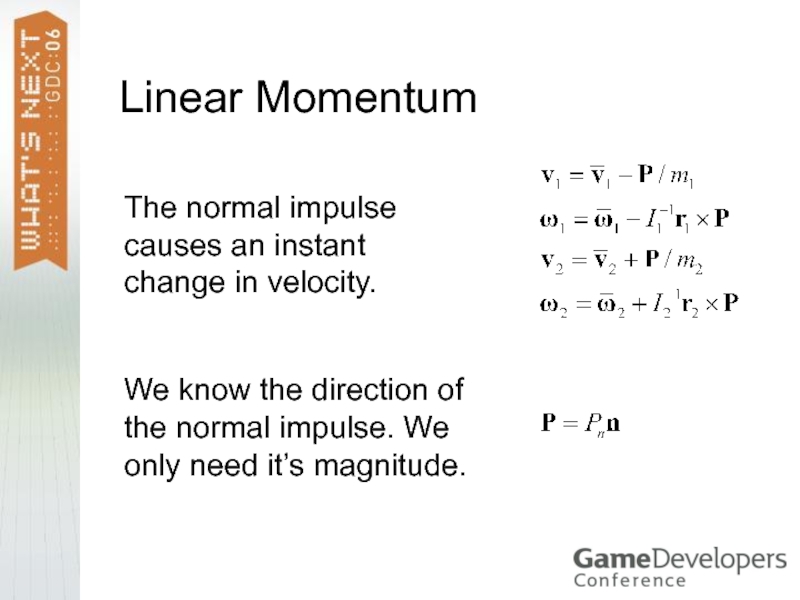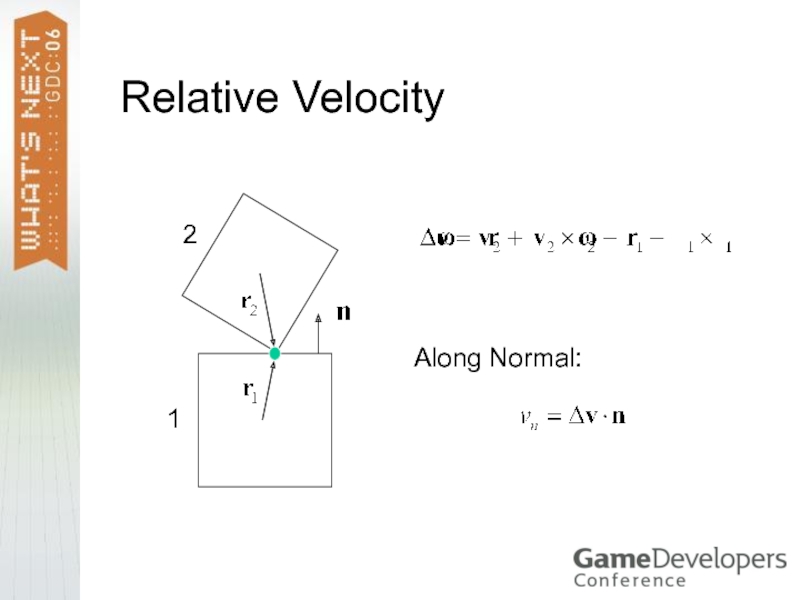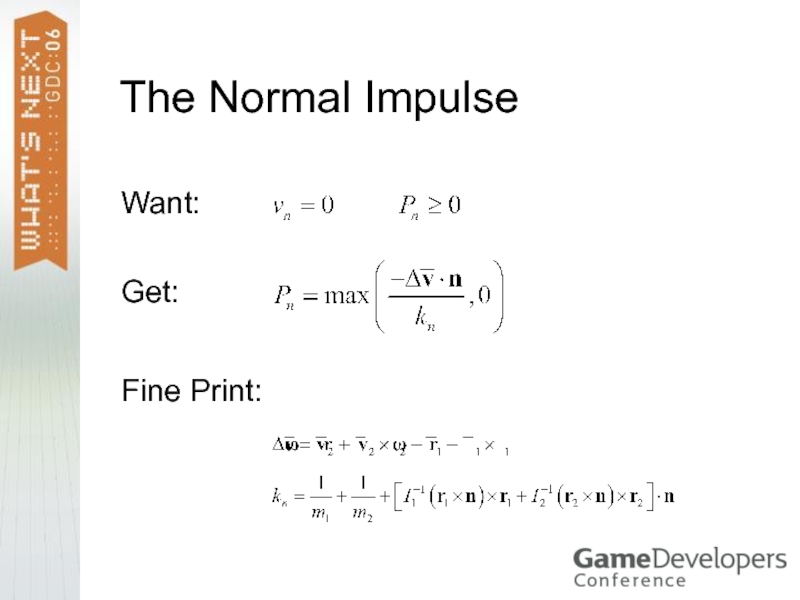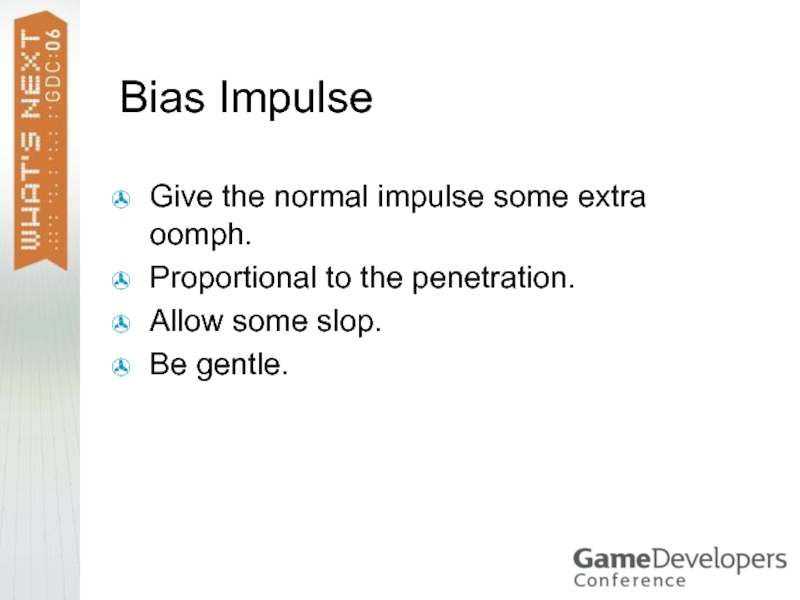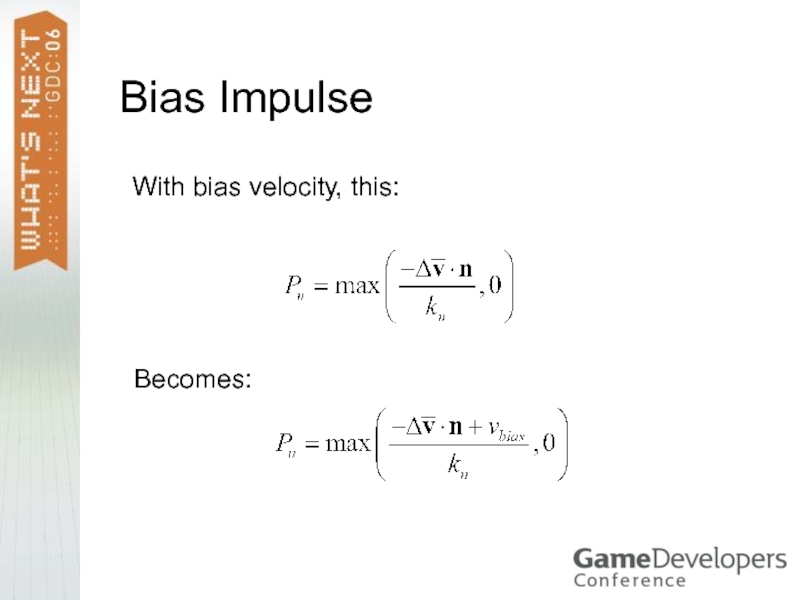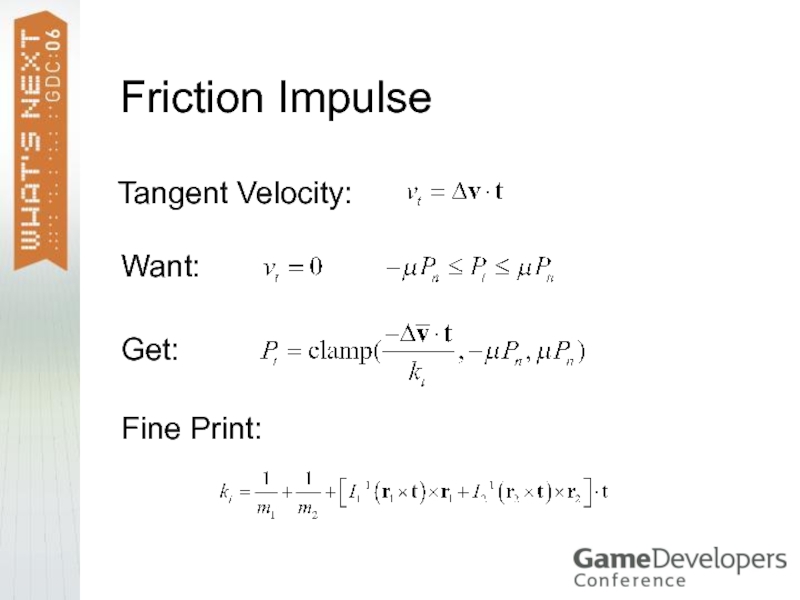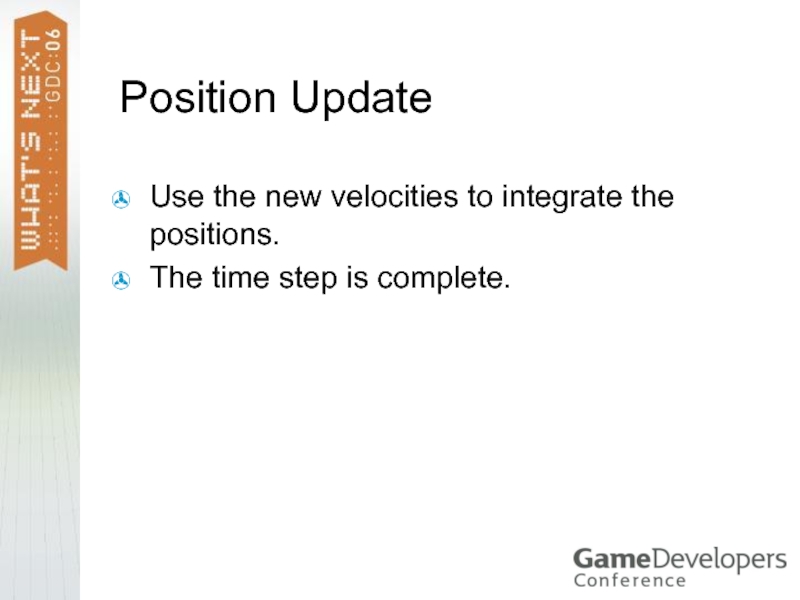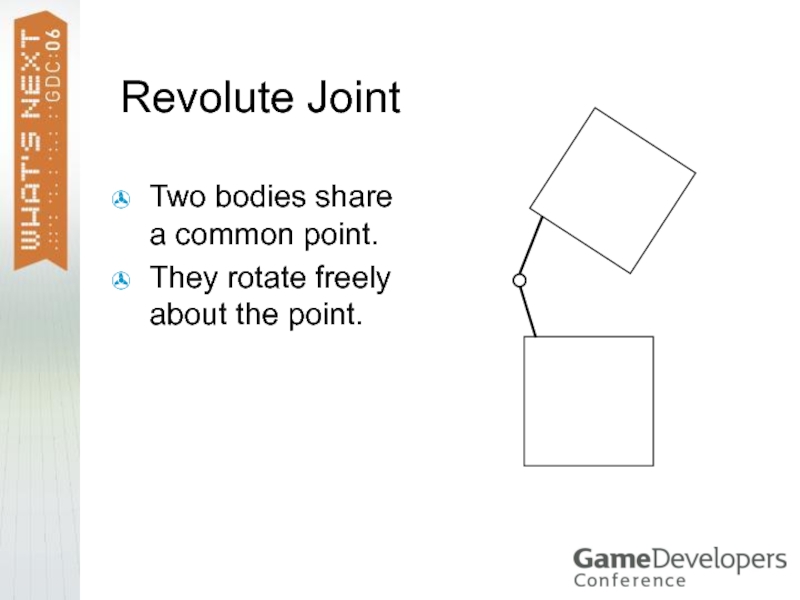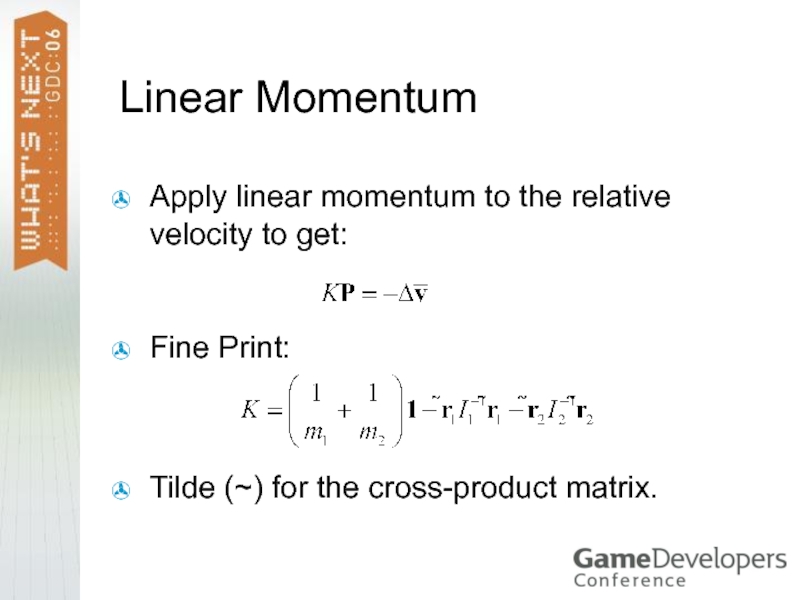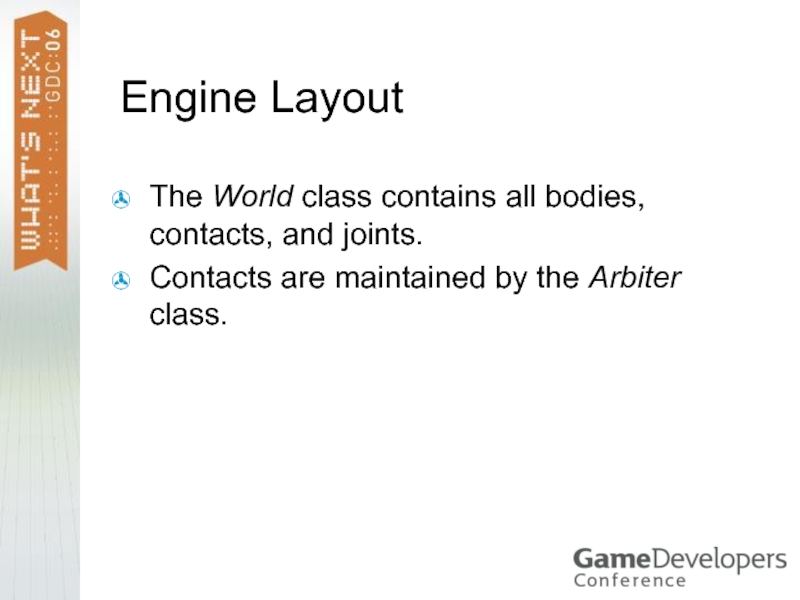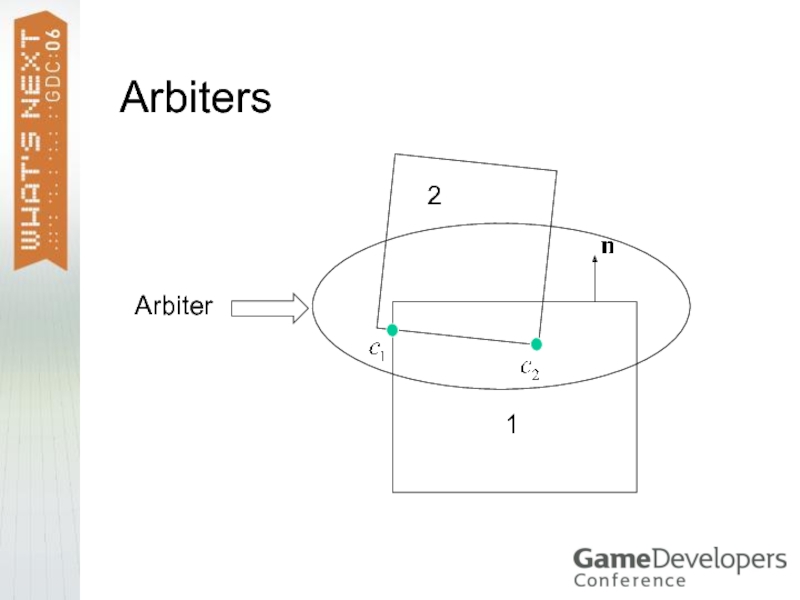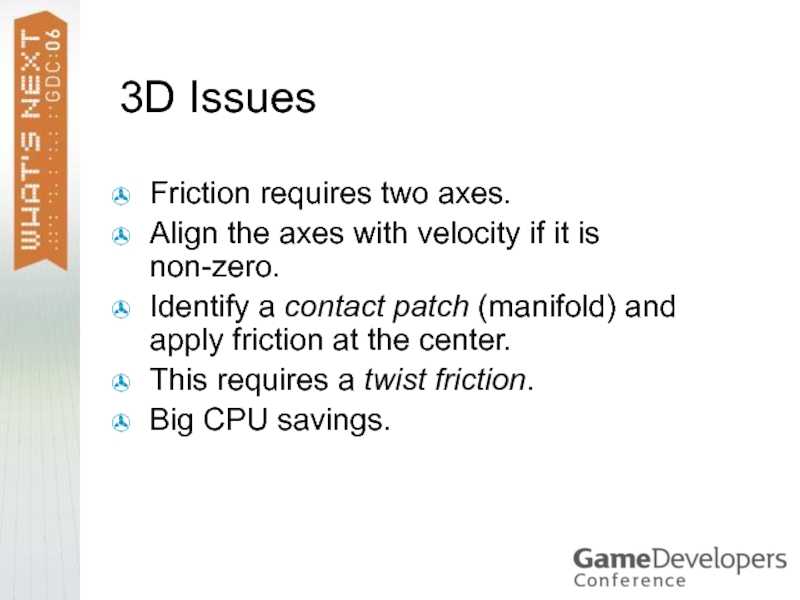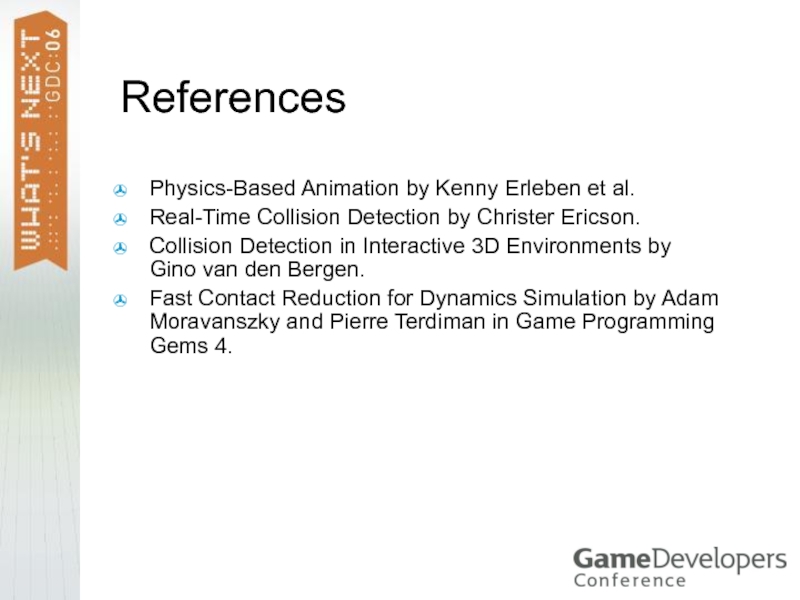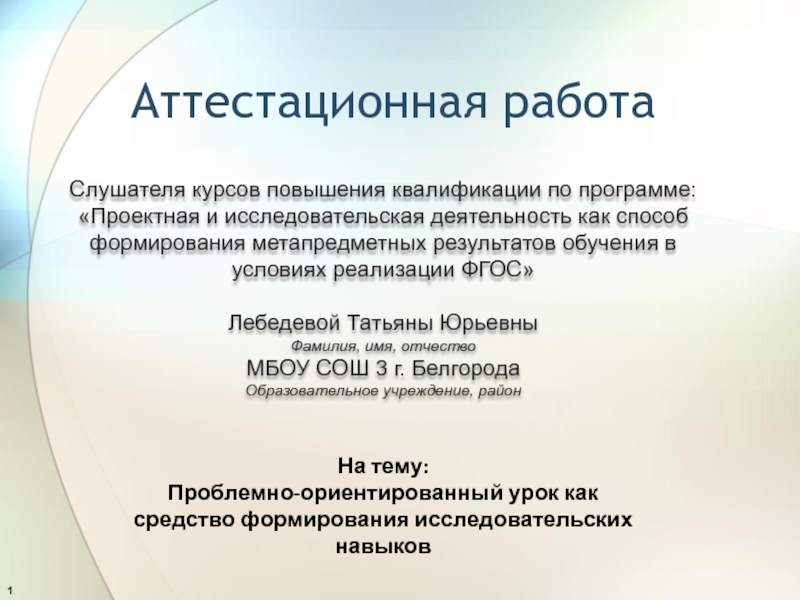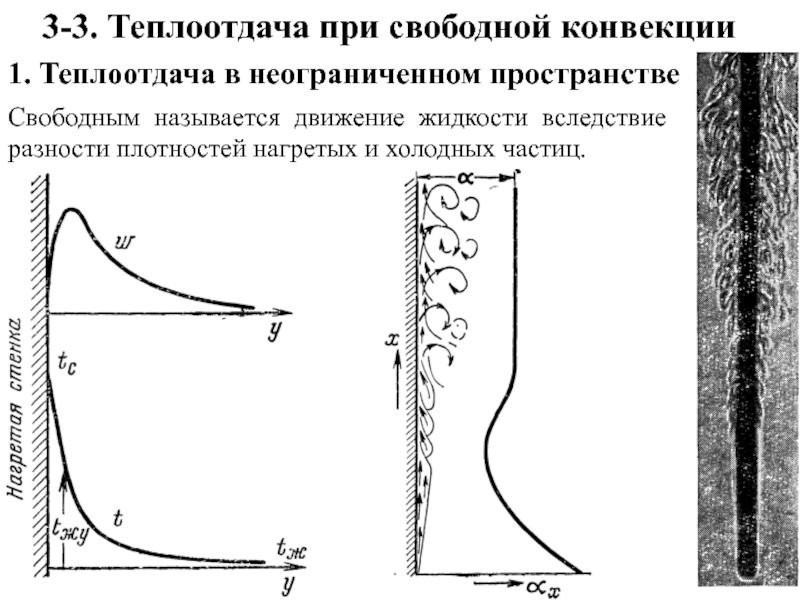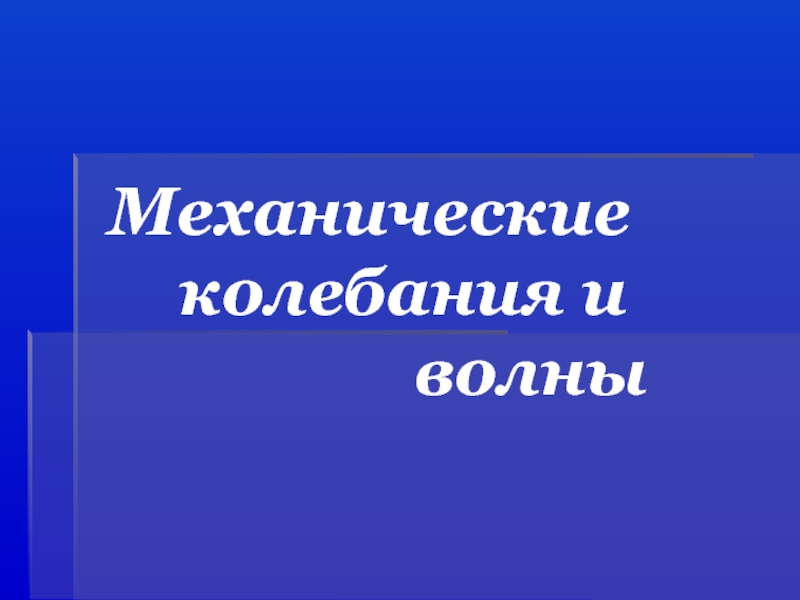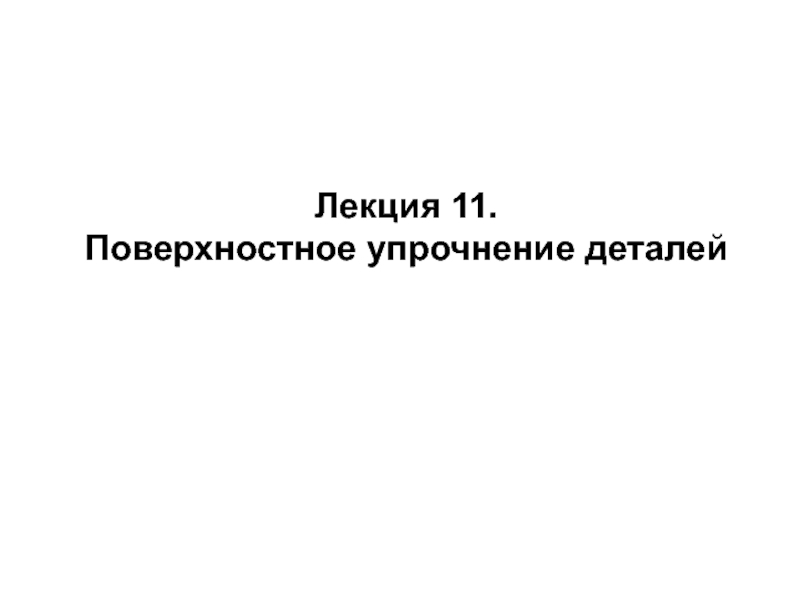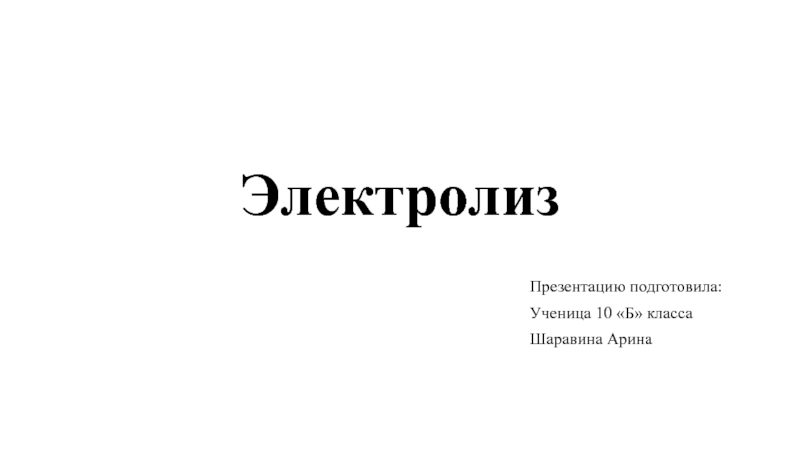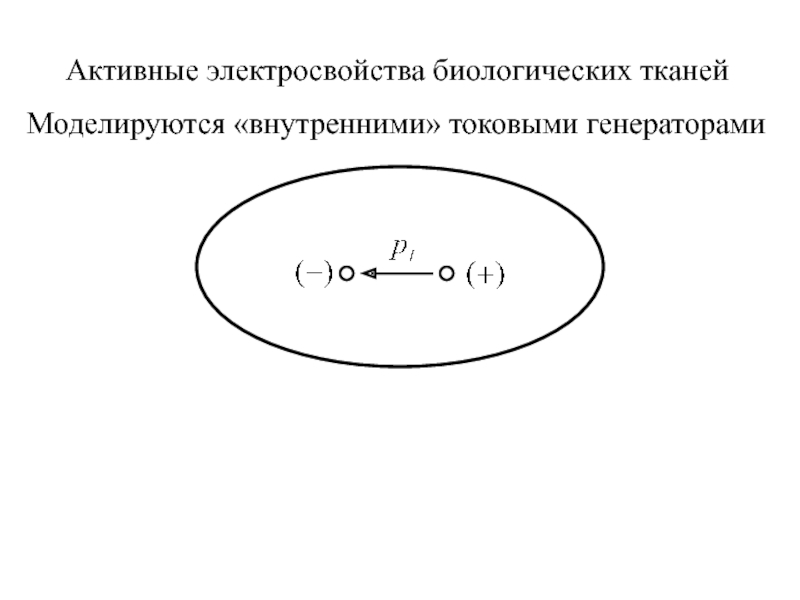- Главная
- Разное
- Дизайн
- Бизнес и предпринимательство
- Аналитика
- Образование
- Развлечения
- Красота и здоровье
- Финансы
- Государство
- Путешествия
- Спорт
- Недвижимость
- Армия
- Графика
- Культурология
- Еда и кулинария
- Лингвистика
- Английский язык
- Астрономия
- Алгебра
- Биология
- География
- Детские презентации
- Информатика
- История
- Литература
- Маркетинг
- Математика
- Медицина
- Менеджмент
- Музыка
- МХК
- Немецкий язык
- ОБЖ
- Обществознание
- Окружающий мир
- Педагогика
- Русский язык
- Технология
- Физика
- Философия
- Химия
- Шаблоны, картинки для презентаций
- Экология
- Экономика
- Юриспруденция
Fast and Simple Physics using Sequential Impulses презентация
Содержание
- 1. Fast and Simple Physics using Sequential Impulses
- 2. Physics Engine Checklist Collision and contact Friction:
- 3. Box2D Demo It’s got collision It’s got
- 4. Fast and Simple Physics Penalty method? Nope
- 5. Why Impulses? Most people don’t hate impulses
- 6. Making Impulses not Suck Impulses are good
- 7. Impulses without the Bounce Forget bounces for
- 8. The 5 Step Program Accept penetration Remember
- 9. Penetration Performance Simplicity Coherence Game logic Fewer cracks
- 10. Algorithm Overview Compute contact points Apply forces (gravity) Apply impulses Update position Loop
- 11. Contact Points Position, normal, and penetration Box-box
- 12. Box-Box SAT First find the
- 13. Box-Box Clipping Setup Identify reference face Identify incident face incident reference
- 14. Box-Box Clipping Clip incident face against reference
- 15. Feature Flip-Flop Which normal is the separating
- 16. Apply Forces Newton’s Law Ignore gyroscopic term for improved stability Use Euler’s rule
- 17. Impulses Impulses are applied at each contact
- 18. Computing the Impulse 1 2
- 19. Linear Momentum We know the direction of
- 20. Relative Velocity Along Normal:
- 21. The Normal Impulse Want: Get: Fine Print:
- 22. Bias Impulse Give the normal impulse some
- 23. Bias Velocity Slop: Bias Factor: Bias velocity:
- 24. Bias Impulse Becomes: With bias velocity, this:
- 25. Friction Impulse Want: Get: Fine Print: Tangent Velocity:
- 26. Sequential Impulses Apply an impulse at each
- 27. Naïve Impulses velocity
- 28. Where Did We Go Wrong? Each contact
- 29. Accumulated Impulses velocity
- 30. The True Impulse Each impulse adds to
- 31. Accumulated Impulse Clamp the accumulated impulse, not the incremental impulses. Accumulated impulses:
- 32. Correct Clamping Normal Clamping: Friction Clamping:
- 33. Position Update Use the new velocities to integrate the positions. The time step is complete.
- 34. Extras Coherence Feature-based contact points Joints Engine layout Loose ends 3D Issues
- 35. Coherence Apply old accumulated impulses at the
- 36. Feature-Based Contact Points Each contact point is
- 37. Contact Point IDs
- 38. Joints Specify (constrain) part of the motion.
- 39. Revolute Joint Two bodies share a common
- 40. Revolute Joint The joint knows the local
- 41. Relative Velocity The relative velocity of the
- 42. Linear Momentum Apply linear momentum to the
- 43. K Matrix 2-by-2 matrix in 2D, 3-by-3
- 44. Bias Impulse The error is the separation
- 45. Engine Layout The World class contains all
- 46. Arbiter An arbiter exists for every touching
- 47. Arbiters 1 2 Arbiter
- 48. Collision Coherence Use the arbiter to store
- 49. More on Arbiters Arbiters are stored in
- 50. Loose Ends Ground is represented with bodies
- 51. 3D Issues Friction requires two axes. Align
- 52. Questions? http://www.gphysics.com erincatto at that domain Download the code there. Buy Tomb Raider Legend!
- 53. References Physics-Based Animation by Kenny Erleben et
Слайд 2Physics Engine Checklist
Collision and contact
Friction: static and dynamic
Stacking
Joints
Fast, simple, and robust
Слайд 3Box2D Demo
It’s got collision
It’s got friction
It’s got stacking
It’s got joints
Check the
code, it’s simple!
Слайд 4Fast and Simple Physics
Penalty method?
Nope
Linear complementarity (LCP)?
Nope
Joint coordinates (Featherstone)?
Nope
Particles (Jakobsen)?
Nope
Impulses?
Bingo!
Слайд 5Why Impulses?
Most people don’t hate impulses
The math is almost understandable
Intuition often
works
Impulses can be robust
Impulses can be robust
Слайд 6Making Impulses not Suck
Impulses are good at making things bounce.
Many attempts
to use impulses leads to bouncy simulations (aka jitter).
Forget static friction.
Forget stacking.
Forget static friction.
Forget stacking.
Слайд 7Impulses without the Bounce
Forget bounces for a moment.
Let’s concentrate on keeping
things still.
It’s always easy to add back in the bounce.
It’s always easy to add back in the bounce.
Слайд 8The 5 Step Program
Accept penetration
Remember the past
Apply impulses early and often
Pursue
the true impulse
Update position last
Update position last
(for taking the jitter out of impulses)
Слайд 10Algorithm Overview
Compute contact points
Apply forces (gravity)
Apply impulses
Update position
Loop
Слайд 11Contact Points
Position, normal, and penetration
Box-box using the SAT
Find the axis of
minimum penetration
Find the incident face on the other box
Clip
Find the incident face on the other box
Clip
Слайд 12Box-Box SAT
First find the separating axis with the minimum penetration.
In 2D
the separating axis is a face normal.
Слайд 14Box-Box Clipping
Clip incident face against reference face side planes (but not
the reference face).
Consider clip points with positive penetration.
Consider clip points with positive penetration.
clipping planes
Слайд 15Feature Flip-Flop
Which normal is the separating axis?
Apply weightings to prefer one
axis over another.
Improved coherence.
Improved coherence.
Слайд 17Impulses
Impulses are applied at each contact point.
Normal impulses to prevent penetration.
Tangent
impulses to impose friction.
Слайд 19Linear Momentum
We know the direction of the normal impulse. We only
need it’s magnitude.
The normal impulse causes an instant change in velocity.
Слайд 22Bias Impulse
Give the normal impulse some extra oomph.
Proportional to the penetration.
Allow
some slop.
Be gentle.
Be gentle.
Слайд 26Sequential Impulses
Apply an impulse at each contact point.
Continue applying impulses for
several iterations.
Terminate after:
- fixed number of iterations
- impulses become small
Terminate after:
- fixed number of iterations
- impulses become small
Слайд 28Where Did We Go Wrong?
Each contact point forgets its impulse history.
Each
contact point requires that every impulse be positive.
There is no way to recover from a bad impulse.
There is no way to recover from a bad impulse.
Слайд 30The True Impulse
Each impulse adds to an accumulated impulse for each
contact point.
The accumulated impulse approaches the true impulse (hopefully).
True impulse: an exact global solution.
The accumulated impulse approaches the true impulse (hopefully).
True impulse: an exact global solution.
Слайд 31Accumulated Impulse
Clamp the accumulated impulse, not the incremental impulses.
Accumulated impulses:
Слайд 35Coherence
Apply old accumulated impulses at the beginning of the step.
Less iterations
and greater stability.
We need a way to match old and new contacts.
We need a way to match old and new contacts.
Слайд 36Feature-Based Contact Points
Each contact point is the result of clipping.
It is
the junction of two different edges.
An edge may come from either box.
Store the two edge numbers with each contact point – this is the Contact ID.
An edge may come from either box.
Store the two edge numbers with each contact point – this is the Contact ID.
Слайд 38Joints
Specify (constrain) part of the motion.
Compute the impulse necessary to achieve
the constraint.
Use an accumulator to pursue the true impulse.
Bias impulse to prevent separation.
Use an accumulator to pursue the true impulse.
Bias impulse to prevent separation.
Слайд 41Relative Velocity
The relative velocity of the anchor points is zero.
An impulse
is applied to the two bodies.
Слайд 42Linear Momentum
Apply linear momentum to the relative velocity to get:
Fine Print:
Tilde
(~) for the cross-product matrix.
Слайд 43K Matrix
2-by-2 matrix in 2D, 3-by-3 in 3D.
Symmetric positive definite.
Think of
K as the inverse mass matrix of the constraint.
Слайд 44Bias Impulse
The error is the separation between the anchor points
Center of
mass: x
Bias velocity and impulse:
Bias velocity and impulse:
Слайд 45Engine Layout
The World class contains all bodies, contacts, and joints.
Contacts are
maintained by the Arbiter class.
Слайд 46Arbiter
An arbiter exists for every touching pair of boxes.
Provides coherence.
Matches new
and old contact points using the Contact ID.
Persistence of accumulated impulses.
Persistence of accumulated impulses.
Слайд 48Collision Coherence
Use the arbiter to store the separating axis.
Improve performance at
the cost of memory.
Use with broad-phase.
Use with broad-phase.
Слайд 49More on Arbiters
Arbiters are stored in a set according to the
ordered body pointers.
Use time-stamping to remove stale arbiters.
Joints are permanent arbiters.
Arbiters can be used for game logic.
Use time-stamping to remove stale arbiters.
Joints are permanent arbiters.
Arbiters can be used for game logic.
Слайд 50Loose Ends
Ground is represented with bodies whose inverse mass is zero.
Contact
mass can be computed as a pre-step.
Bias impulses shouldn’t affect the velocity state (TODO).
Bias impulses shouldn’t affect the velocity state (TODO).
Слайд 513D Issues
Friction requires two axes.
Align the axes with velocity if it
is non-zero.
Identify a contact patch (manifold) and apply friction at the center.
This requires a twist friction.
Big CPU savings.
Identify a contact patch (manifold) and apply friction at the center.
This requires a twist friction.
Big CPU savings.
Слайд 52Questions?
http://www.gphysics.com
erincatto at that domain
Download the code there.
Buy Tomb Raider Legend!
Слайд 53References
Physics-Based Animation by Kenny Erleben et al.
Real-Time Collision Detection by Christer
Ericson.
Collision Detection in Interactive 3D Environments by Gino van den Bergen.
Fast Contact Reduction for Dynamics Simulation by Adam Moravanszky and Pierre Terdiman in Game Programming Gems 4.
Collision Detection in Interactive 3D Environments by Gino van den Bergen.
Fast Contact Reduction for Dynamics Simulation by Adam Moravanszky and Pierre Terdiman in Game Programming Gems 4.
